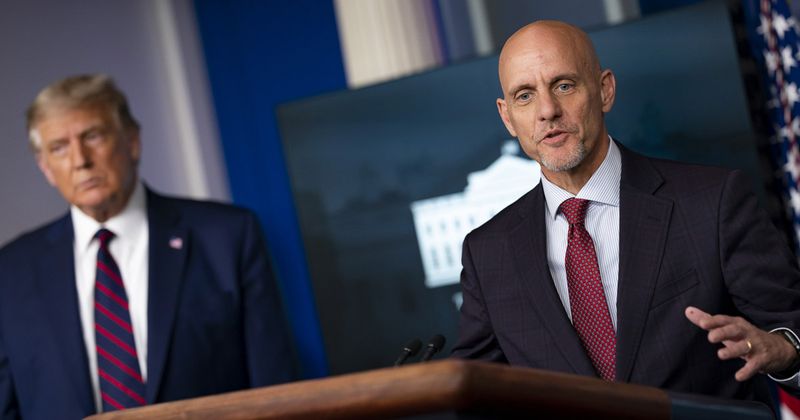FDA OKs convalescent plasma for COVID-19 amid questions about its usefulness
Click Here to Manage Email Alerts
On Sunday, the FDA authorized the emergency use of convalescent plasma as a therapy for patients hospitalized with COVID-19, saying the “known and potential benefits” of the technique outweigh any risks.
FDA Commissioner Stephen M. Hahn, MD, said the agency was “encouraged” by initial data showing that patients with COVID-19 who received convalescent plasma early enough in their illness were less likely to die.

Credit: Official White House photo by Shealah Craighead
Others questioned the timing of the emergency use authorization (EUA) while trials assessing convalescent plasma for COVID-19 therapy are ongoing.
“An EUA allows unproven or unapproved therapy to be used in serious conditions when there are no therapies available. At the moment, we have remdesivir and dexamethasone, which are already available, so an EUA for convalescent plasma seems unnecessary,” Carlos del Rio, MD, distinguished professor of medicine and executive associate dean at Emory University School of Medicine, told Healio.
Convalescent plasma uses blood plasma from recovered donors to transfer antibodies against a virus to other patients. Physicians have used it for more than a century as a therapy against diseases such as influenza, SARS and Ebola.
During a White House press briefing, Hahn said close to 100,000 patients have enrolled in an expanded access program for convalescent plasma that began in April at the Mayo Clinic, and more than 70,000 of them have received it as treatment for COVID-19.
“In the independent judgement of experts and expert scientists at FDA ... COVID-19 convalescent plasma is safe and shows promising efficacy, thereby meeting the criteria for an emergency use authorization,” Hahn said.
Infectious Diseases Society of America President and Infectious Disease News Editorial Board Member Thomas M. File Jr., MD, FIDSA, noted what he called “positive signals” from studies on convalescent plasma as a treatment for COVID-19 but said results from a randomized controlled trial are necessary to determine its true benefit.
“For this reason, IDSA supports the continued collection of data in randomized clinical trials to better understand the benefits of convalescent plasma treatment before authorizing its wider use in patients with COVID-19,” File said in a statement released by the IDSA.
Del Rio said the EUA could slow enrollment in such trials and is “unlikely to improve access to convalescent plasma.”
In remarks during the press briefing, President Donald J. Trump called convalescent plasma “a powerful therapy” and heralded the EUA as a “breakthrough.”
“This is a major advance in the treatment of patients,” HHS Secretary Alex Azar II said during the briefing.
Other leading experts have questioned the strength of the emerging data backing the EUA.
According to a report in The New York Times, opponents of the authorization included NIH Director Francis S. Collins, MD, PhD, and National Institute of Allergy and Infectious Diseases Director Anthony S. Fauci, MD, who urged officials to delay issuing the EUA, citing the data as too weak.
The data cited by Azar, Hahn and Trump on Sunday came from a study published this month by medRxiv — a preprint server — that showed some benefit from the technique. In the federally funded study, the pooled relative risk for mortality among patients who received transfusions of plasma with high antibody levels was 0.65 (95% CI, 0.47-0.92) for 7 days and 0.77 (95% CI, 0.63-0.94) for 30 days compared with patients who received low antibody plasma units.
The patients enrolled in the study were either hospitalized with “severe or life-threatening acute COVID-19,” or were at risk for it. Patients who were treated within 3 days of diagnosis with high antibody plasma units saw the most benefit from the treatment.
Researchers said the results, which were not peer reviewed, “provide signatures of efficacy for convalescent plasma in the treatment of hospitalized COVID-19 patients.” Del Rio said the study showed a “very mild benefit” from the therapy.
“The emerging data do not suggest convalescent plasma is that great. It is at best an incremental improvement but not a game changer,” he said.
Arturo Casadevall, MD, PhD, the chair of molecular microbiology and immunology at Johns Hopkins Bloomberg School of Public Health and senior author of the medRxiv paper, said the FDA authorization “addresses an important health equity issue” in the U.S.
“Plasma was already available in well-resourced hospitals but understaffed hospitals caring for [underserved] populations struggled with the paperwork under the prior regs. EUA makes usage easier,” he tweeted.
In a weekend tweet, Trump accused the FDA of delaying the testing of vaccines and therapeutics for COVID-19 until after the presidential election, writing, “Must focus on speed, and saving lives!” He tagged Hahn at the end of the tweet. Hahn did not respond to a reporter who asked at the end of the White House press briefing if he felt pressure to issue the EUA.
References:
- FDA. News release. https://www.fda.gov/news-events/press-announcements/fda-issues-emergency-use-authorization-convalescent-plasma-potential-promising-covid-19-treatment. Accessed August 23, 2020.
- Joyner MJ, et al. medRxiv. 2020;doi:10.1101/2020.08.12.20169359.
- Weiland N, et al. FDA’s emergency approval of blood plasma is now on hold. The New York Times. Accessed August 23, 2020.

